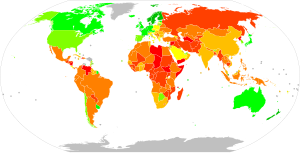
Back الفساد في الهند Arabic भारत में भ्रष्टाचार Bihari Korruption in Indien German भारत में भ्रष्टाचार Hindi ਭਾਰਤ ਵਿੱਚ ਭ੍ਰਿਸ਼ਟਾਚਾਰ Punjabi بھارت وچ بدعنوانی PNB இந்தியாவில் ஊழல் Tamil بھارت میں بدعنوانی Urdu

| Political corruption |
|---|
 |
| Forms and concepts |
| Anti-corruption |
| Corruption by country |
Corruption in India is an issue which affects economy of central, state, and local government agencies. Corruption is blamed for stunting the economy of India.[1] A study conducted by Transparency International in 2005 recorded that more than 62% of Indians had at some point or another paid a bribe to a public official to get a job done.[2][3] In 2008, another report showed that about 50% of Indians had first hand experience of paying bribes or using contacts to get services performed by public offices.[4] In Transparency International's 2023 Corruption Perceptions Index, which scored 180 countries on a scale from 0 ("highly corrupt") to 100 ("very clean"), India scored 39. When ranked by score, India ranked 93rd among the 180 countries in the Index, where the country ranked first is perceived to have the most honest public sector.[5] For comparison with worldwide scores, the best score was 90 (ranked 1), the worst score was 11 (ranked 180), and the average score was 43.[6] For comparison with regional scores, the highest score among the countries of the Asia Pacific region[Note 1] was 85, the lowest score was 17, and the average score was 45.[7] Various factors contribute to corruption, including officials siphoning money from government social welfare schemes. Examples include the Mahatma Gandhi National Rural Employment Guarantee Act and the National Rural Health Mission.[8][9] Other areas of corruption include India's trucking industry, which is forced to pay billions of rupees in bribes annually to numerous regulatory and police stops on interstate highways.[10]
The media has widely published allegations of corrupt Indian citizens stashing millions of rupees in Swiss banks. Swiss authorities denied these allegations, which were later proven in 2015–2016. In July 2021, India's Central Board of Direct Taxes (CBDT) replied to Right To Information (RTI) requests stating undeclared assets of Rs 20,078 crore identified by them in India and abroad following the investigation till June 2021.[11][12][13]
The causes of corruption in India include excessive regulations, complicated tax and licensing systems, numerous government departments with opaque bureaucracy and discretionary powers, monopoly of government controlled institutions on certain goods and services delivery, and the lack of transparent laws and processes.[14][15] There are significant variations in the level of corruption and in the government's efforts to reduce corruption across India.
- ^ Nirvikar Singh (19 December 2010). "The trillion-dollar question". The Financial Express. Archived from the original on 29 November 2012.
- ^ Transparency International – the global coalition against corruption, Transparency.org, archived from the original on 24 July 2011, retrieved 7 October 2011
- ^ "India Corruption Study 2005: To Improve Governance: Volume I – Key Highlights New Delhi" (PDF). Transparency International India. 30 June 2005. pp. 1–3. Archived from the original (PDF) on 11 August 2013.
- ^ "India Corruption Study – 2008" (PDF). Transparency International. 2008. Archived from the original (PDF) on 19 June 2012. Retrieved 6 July 2012.
- ^ "The ABCs of the CPI: How the Corruption Perceptions Index is calculated". Transparency.org. Retrieved 15 April 2023.
- ^ "Corruption Perceptions Index 2023: India". Transparency.org. Retrieved 30 January 2024.
- ^ "CPI 2023 for Asia Pacific: Regional Stagnation Marked by Inadequate Delivery of Anti-corruption Commitments". Transparency.org. Retrieved 30 January 2023.
- ^ "India to give free medicine to millions". The Financial Times. 5 July 2012.
- ^ Cite error: The named reference
econ1was invoked but never defined (see the help page). - ^ Cite error: The named reference
asia2009was invoked but never defined (see the help page). - ^ "Panama Papers: Rs 20,000 crore in undeclared assets identified". The Indian Express. 5 July 2021. Retrieved 8 July 2021.
- ^ Cite error: The named reference
fm2012was invoked but never defined (see the help page). - ^ Cite error: The named reference
swissinfowas invoked but never defined (see the help page). - ^ Cite error: The named reference
kpmg2011was invoked but never defined (see the help page). - ^ Cite error: The named reference
WFR2011was invoked but never defined (see the help page).
Cite error: There are <ref group=Note> tags on this page, but the references will not show without a {{reflist|group=Note}} template (see the help page).
© MMXXIII Rich X Search. We shall prevail. All rights reserved. Rich X Search